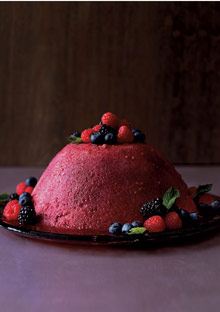
Photo: Anna Williams
Berry-filled, syrupy, spongy, or jam-laden, her Irish grandmother's puddings gave off the fragrance, taste, and pure essence of the season. Moira Hodgson keeps an olde tradition alive.
When she wasn't in her science lab pouring things into test tubes and creating noxious fumes over Bunsen burners, my Irish grandmother loved to cook. She was a science teacher at a girls' school in the town of Sherborne, in Dorset, England, where she had moved in 1922 to escape the "Troubles" in Ireland. Sherborne is a beautiful place filled with ancient buildings made of honey-colored stone and dominated by a famous abbey. For six years, it was my home, too, not only because I was a boarder at the school but also because my parents were overseas (my father was in the British Foreign Office), so I often spent weekends and vacations at my grandmother's house. She became a central figure in my life, and a deep bond developed between us. In the kitchen, where we spent much of our time, we discussed religion, politics, science, literature, and, of course, Ireland. When we talked, she'd use a rolling pin, a wooden spoon, or a saucepan—whatever was at hand—to drive her point home, like Khrushchev when he banged his shoe on the table at the United Nations. Her food reflected her personality: She threw herself into it unconditionally and with passion. Her pastry was irresistible, her stews a legend among my schoolmates, and her scrambled eggs all the richer for the two extra yolks she cracked in. (Butter, eggs, and cream had been rationed during World War II, so she was making up for it by the time I lived with her in the late 1950s and early '60s.)
And she had the touch. When she tasted something that really pleased her, she would puff out her chest and announce with pride, "You could give this to anyone!"
We cooked and talked, digging our hands into the flour bin and rolling out pastry, shaping brandy snaps around the handles of wooden spoons the moment they emerged from the oven, frying potato pancakes in the bacon fat she collected in a can at the back of the stove, and even boning a whole chicken and then stuffing it with sausage meat and pistachios.
Much of what we made came from my grandmother's recipe book. In 1918, a year after she married my grandfather, she had begun writing down her favorite recipes in a neat, flowery hand. Forty-eight years (and nearly a lifetime of cooking) later, she copied one for Carnation chocolate soufflé onto the last of the book's 300 pages. The recipe called for evaporated milk. Beneath it, she wrote, Note by H.O.H. [her initials]: Try fresh cream instead.
My grandmother's book, which I preserve in plastic, no longer has a cover, and its lined pages are brown with age. But it is full of memories—of baking cakes and rising loaves of bread, warm casseroles and stews, gooseberry and rhubarb fools, and apple pies made with the wormy apples from the garden, which were crisper and juicier than anything you could buy. Nearly half the recipes are for puddings, a term she, like most of her countrymen, used to refer to a great variety of dishes, most of them sweet (like plum pudding) but a few savory (like Yorkshire pudding). Puddings of all kinds were as integral a part of a meal in Britain as cheese was for a Frenchman and pasta for an Italian (Lawrence Durrell called England Pudding Island). My grandmother's puddings were steamed in a deep, round china bowl with a thick rim, covered with waxed paper or a dishcloth tied around with string, and placed in water, three-quarters up the side.
After a "good beef stew" or a glazed ham with parsley sauce, a dessert pudding would be brought to the table. Canary pudding was a yellow sponge light as a soufflé and drenched in Lyle's Golden Syrup poured straight from its green and gold tin. Queen's pudding was topped with raspberry jam and a halo of meringue, steamed chocolate pudding was accompanied by creamy chocolate custard, and, for Christmas, plum pudding would be doused with brandy and arrive at the table wreathed in flames.
Come summer, when the warm weather set in, my grandmother and I would gather wild blackberries and raspberries that grew along the ancient hedgerows dividing the fields and pastures of Sherborne. We returned home with red-stained mouths and fingers. She would stew the fruits with sugar, adding black currants and red currants from her garden to the mix. She'd line a pudding bowl with stale bread (nothing was thrown away in her house), and we'd pour in the cooked fruit, topping it off with more bread. Then she would put weights on top and leave it overnight in the cool larder so the juices would be pressed into the bread, transforming its texture into a dense, soft pulp. No steaming or baking was required. After lunch, she would bring out the glorious, ruby red, molded dome soaked in sweet and tart juices, along with a jug of thick, yellow Devonshire cream. I loved it because it was beautiful, and because it tasted to me like the very essence of summer.
Now, when local berries arrive at the farmers' market, I make summer pudding and serve it after dinner, outside by the grill. As I carry the glorious dessert from the kitchen on my grandmother's round pink-and-white china platter, scattered with colorful berries, I can almost see her beaming with approval. "That's a fine-looking pudding," she'd have exclaimed. "You could give it to anyone!"




